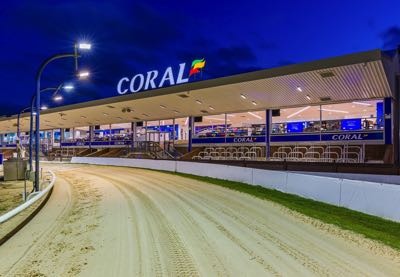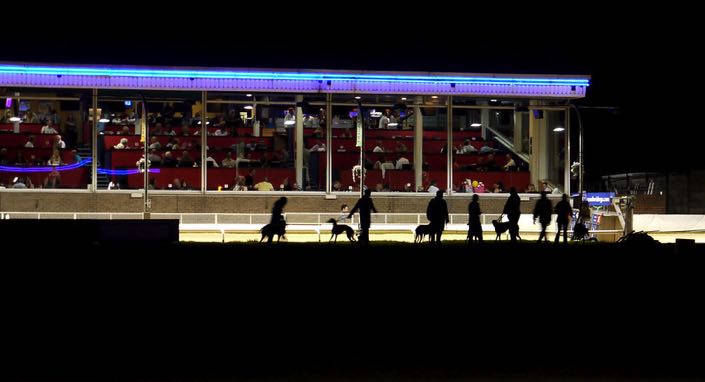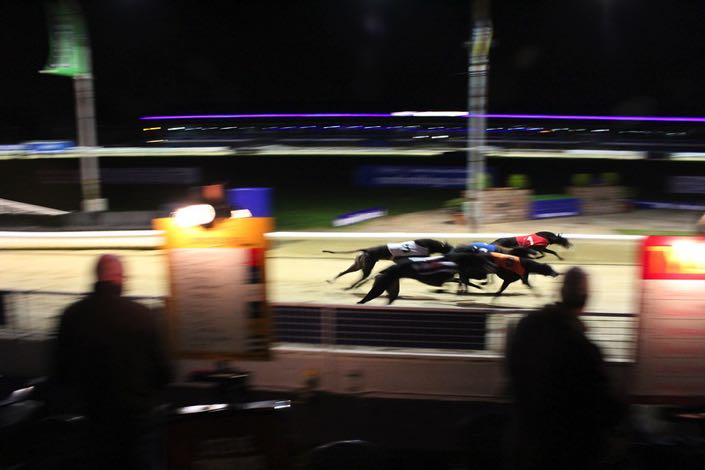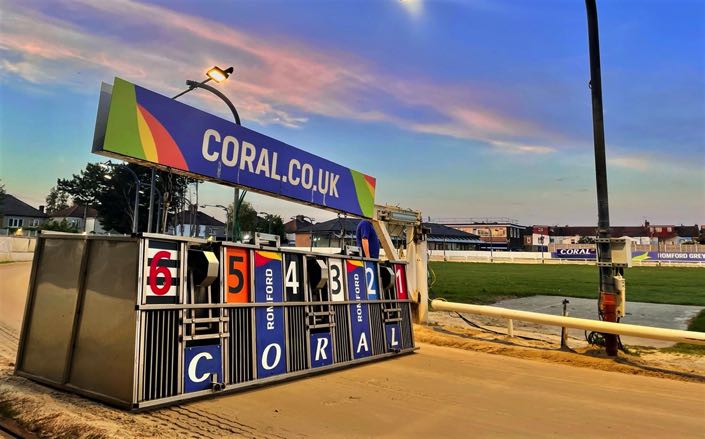- Address: London Rd, Romford RM7 9DU
- Telephone: 01708 773444
- Website: romfordgreyhoundstadium.co.uk

Officially known as Coral Romford Greyhound Stadium because of sponsorship, Romford Greyhound Stadium is, as you might have guessed, a greyhound racing track that is located in the centre of the town of Romford. It is owned and operated by the Ladbrokes Coral Group, hence its sponsored title. There is room for around 1,700 people in the stadium, which has won numerous awards in the years since it first opened. A track was opened in 1929, with a new track built two years later. The site was renovated in 2019, so it is one of the most up-to-date greyhound venues in the country.
Racing takes place at Romford Greyhound Stadium on Monday afternoons, Tuesday mornings, Thursday afternoons and in the evening on both Friday and Saturday. On top of that, there is also some racing action to be head on Sunday mornings and every now and then on Wednesdays. In other words, depending on when you’re wanting to watch the dogs race, there’s a very good chance that there’ll be a meeting on of some sort when you want to go. How much you’ll pay for the privilege is dependent on when you go.
The Track & Facilities

The first thing that it’s important to tell you is that the facilities on offer at the track aren’t all open every time there is a meeting. The both the Paddock Restaurant and the Pavilion Restaurant are only open on Friday and Saturday evenings, for example. The rest of the time you’ll be able to get a bite to eat at one of the snack bars around the place, so you’re unlikely to go hungry just because you’re there on a Sunday. As well as food, you can get a selection of drinks from one of the bars that are on-site, plus there is Tote betting alongside the more traditional trackside bookmakers.
The Coral Stand puts you right next to the action and is incredibly comfortable for spectators. As well as having air conditioning, the area also promises TVs that you can watch the racing on if you don’t fancy heading outside. It is set over two floors, so there is plenty of space there for visitors. Those that are driving will benefit from the free parking, whilst disabled customers will be glad of the lift access on offer. If you’re after a more private experience then the Pavilion Restaurant can be hired for exactly that.
The circumference of the track is 350 metres, whilst racing takes place over the following distances:
- 225 Metres
- 400 Metres
- 575 Metres
- 750 Metres
- 925 Metres
Major Races & Events

The country’s biggest greyhound stadiums offer a wealth of different races between them, with Romford being no exception. Indeed, the venue’s presence in a London suburb means that it offers more than a lot of other places around the United Kingdom. Here is a look at the biggest races that you might be lucky enough to witness if you time your visit to Romford Greyhound Stadium correctly:
The Essex Vase
First run in 1939, the Essex Vase is a racing competition that takes place over 575 metres. It initially ran for a decade before being cancelled, then a decision was taken to bring it back in 1959. No trainer has won the Essex Vase more than Mark Wallis, who won it for the fifth time in 2021. Trainers such as George Curtis, Linda Mullins and Brian Clemonson have had their names on the trophy over the years, whilst the best-known dog to have won it was arguably Ballyregan Bob, victorious in 1985.
Champion Stakes
When the Champion Stakes was held for the first time in 1947, it was hosted by Wimbledon Stadium. It was discontinued in 1973 and remained off the race card until Romford Greyhound Stadium decided to bring it back 15 years later. It has twice been the race that has seen the track record set for the 575 metre distance, initially when Elderberry Chick completed it in 34.86 seconds in 1997 and then again in 2013 when Airport Captain finished the race in 34.67 seconds, which is a time that has yet to be beaten in the race.
Golden Sprint
Run over 400 metres and considered to be one of the most interesting sprint races in greyhound racing, the Golden Sprint was inaugurated in 1987. It has been hosted by Romford Greyhound Stadium since its inception. In 2010, Ardbeg Mentor set the track record over the distance of the race, getting around in 23.56 seconds and pleasing those that backed it with odds of 4/1. As with many races, it has enjoyed numerous different sponsors over the years, with the honour currently, though unsurprisingly, going to Coral.
Romford Puppy Cup
In a ruling that won’t shock anyone that has read the name of the race, the Romford Puppy Cup is limited to dogs aged between 15 and 24 months. They run over a distance of 400 metres. The race was run for the first time in 1975 and the prize money of £10,000 for the winner means that it is one of the leading races for puppies. Indeed, the money on offer is equal to that of the Puppy Derby at Towcester and second only to the Ladbrokes Puppy Derby, which is run at Monmore Green Stadium.
Coronation Cup
Run for the first time in 1981 at Southend Stadium, the Coronation Cup switched to Romford Greyhound Stadium when Southend closed in 1985. Sometimes people confuse it for the Coronation Stakes, but that was a race that took place at Wembley. The dog that completed the 575 metres in the fastest time won £5,000 in 2022. Some of the well-known trainers that have seen their dogs win the race in the past include George Curtis, Linda Mullins and John Coleman.
In the News
In many ways, it is often a good thing when a stadium that hosts greyhound racing has not been in the news, given that it can often be for less than savoury reasons. It is a pleasant exception, then, that Romford’s most recent appearance in a news story came thanks to the fact that the stadium was caught up in the celebrations for the Queen’s Platinum Jubilee. Prior to that, the biggest story concerning the stadium came when an air ambulance landed at the track in 2021.
About Romford Greyhound Stadium

In 1929, Archer Leggett and his brother-in-law rented a small piece of land close to the Crown Hotel and just off Romford’s London road, putting down £400 in order to equip the area ready for greyhound racing. On the 21st of June, privately owned greyhounds were invited to take to the course, which boasted a hare driven by the engine of an old Ford car. The landlord doubled the rent a year later, which was too much for the operation to keep going and so a decision was taken to move it to another location not far away.
About £600 was raised in order to allow Leggett to open a new track, this time located in a field that was within Belle Vue Meadow and adjacent to the railway line of London and North Eastern Railway. It was almost opposite the previous venue and included an electronically operated hare as well as a hand-operated totalisator. The first meeting saw more than 1,000 people turn up on the 20th of September 1931 and four years later a group of new directors ploughed more than £17,000 into the area to convert it to a proper stadium.
Romford’s Cheetah Racing
As the greyhound racing industry began to take off, companies like Romford Stadium Limited began making huge amounts of money. As part of this, Arthur Leggett decided that it made sense to bring cheetah racing to the United Kingdom, having 12 of the animals imported in 1936 by the explorer Kenneth Gandar-Dower. After having been kept in quarantine for six months, they were moved to Romford Stadium on the 11th of December 1937 in order to take part in a race. It was a failed experiment, largely because the cheetahs lost interest when only racing each other.
After the War
As with most greyhound stadiums around the country, Romford’s action was limited during the Second World War. When racing returned in the wake of the war’s conclusion, numerous changes took place to the people behind-the-scenes. Events like the Romford Puppy Cup were introduced, then in 1976 Arthur Leggett, the Managing Director, made the decision to sell the venue to Coral. A year later, Go Ahead Girl, a bitch, won 17 races in a row for Terry Duggan, then a year after that payment for BAGS racing to the National Greyhound Racing Club ended.
In 1982, one of the proudest moments for Romford came when Lauries Panther won the English Greyhound Derby. In the years that followed, the Coronation Cup was moved to Romford, whilst the Golden Sprint was introduced and the Champion Stakes was resurrected. 1996 saw changes afoot, specifically thanks to the move of Peter O’Dowd from Bolton to join the venue as the Racing Manager, replacing Steve Daniel who had not long been in the role after taking over from Ray Spalding.
The Modern Era
A £400,000 refurbishment of the main restaurant in the Grandstand took place in 2006. Eight years later and another highlight for Romford occurred when Paul Young, who had joined the track in 2000, won the Trainers Championship. A deal with SIS was signed in 2018, ensuring that racing would take place on Monday and Thursday afternoons as well as Wednesday, Friday and Saturday evenings, plus Saturday morning. Perhaps the biggest change came in 2019, though, when a multi-million renovation happened.
The main stand was demolished in order to create more room for car parking, then the reception area and office buildings were modernised. A grand stand was built, with a new track being laid down also. Remarkably, the track was only closed for four days whilst all of the renovations took place. In 2020, the Category 1 Cesarewitch was brought back after being dormant for eight years, but it was moved to Crayford Stadium after one running.
Track Records
Obviously track records can be broken at any moment, but at the time of writing, the following are the track records for the distances that have been run at the stadium over the years:
| Distance | Record Time | Date Set |
|---|---|---|
| 225 Metres | 13.18 Seconds | 9th June 2017 |
| 400 Metres | 23.26 Seconds* | 15th September 2017 |
| 575 Metres | 34.59 Seconds** | 22nd November 2019 |
| 750 Metres | 46.37 Seconds | 12th December 2012 |
| 925 Metres | 58.57 Seconds*** | 6th September 2019 |
| 1,100 Metres | 72.59 Seconds | 10th March 1987 |
| 400 Metre Hurdles | 24.07 Seconds | 12th March 2010 |
| 575 Metre Hurdles | 35.53 Seconds | 19th February 1999 |
*Record set during the Romford Puppy Cup; **Record set during the Essex Vase; ***Record set during the TV Trophy